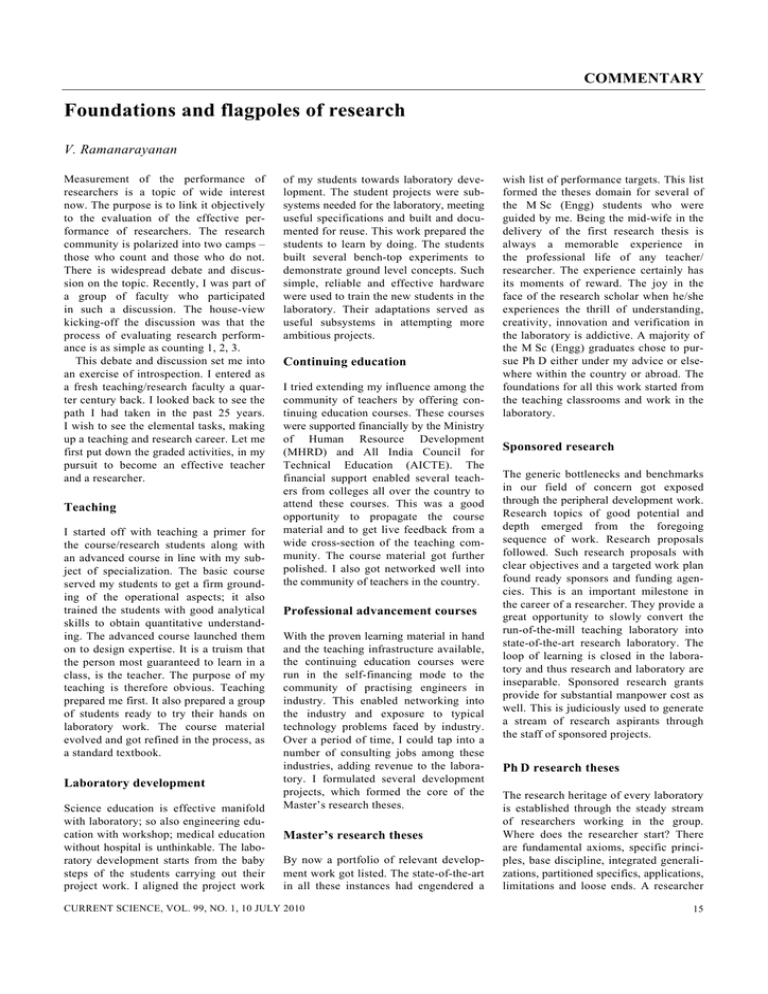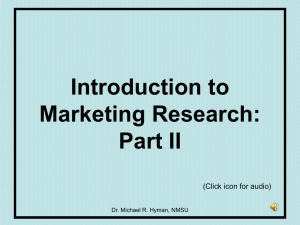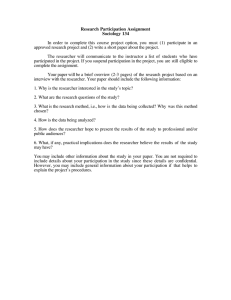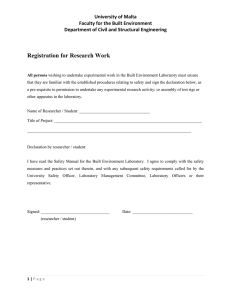Foundations and flagpoles of research COMMENTARY V. Ramanarayanan
advertisement

COMMENTARY Foundations and flagpoles of research V. Ramanarayanan Measurement of the performance of researchers is a topic of wide interest now. The purpose is to link it objectively to the evaluation of the effective performance of researchers. The research community is polarized into two camps – those who count and those who do not. There is widespread debate and discussion on the topic. Recently, I was part of a group of faculty who participated in such a discussion. The house-view kicking-off the discussion was that the process of evaluating research performance is as simple as counting 1, 2, 3. This debate and discussion set me into an exercise of introspection. I entered as a fresh teaching/research faculty a quarter century back. I looked back to see the path I had taken in the past 25 years. I wish to see the elemental tasks, making up a teaching and research career. Let me first put down the graded activities, in my pursuit to become an effective teacher and a researcher. Teaching I started off with teaching a primer for the course/research students along with an advanced course in line with my subject of specialization. The basic course served my students to get a firm grounding of the operational aspects; it also trained the students with good analytical skills to obtain quantitative understanding. The advanced course launched them on to design expertise. It is a truism that the person most guaranteed to learn in a class, is the teacher. The purpose of my teaching is therefore obvious. Teaching prepared me first. It also prepared a group of students ready to try their hands on laboratory work. The course material evolved and got refined in the process, as a standard textbook. Laboratory development Science education is effective manifold with laboratory; so also engineering education with workshop; medical education without hospital is unthinkable. The laboratory development starts from the baby steps of the students carrying out their project work. I aligned the project work of my students towards laboratory development. The student projects were subsystems needed for the laboratory, meeting useful specifications and built and documented for reuse. This work prepared the students to learn by doing. The students built several bench-top experiments to demonstrate ground level concepts. Such simple, reliable and effective hardware were used to train the new students in the laboratory. Their adaptations served as useful subsystems in attempting more ambitious projects. Continuing education I tried extending my influence among the community of teachers by offering continuing education courses. These courses were supported financially by the Ministry of Human Resource Development (MHRD) and All India Council for Technical Education (AICTE). The financial support enabled several teachers from colleges all over the country to attend these courses. This was a good opportunity to propagate the course material and to get live feedback from a wide cross-section of the teaching community. The course material got further polished. I also got networked well into the community of teachers in the country. Professional advancement courses With the proven learning material in hand and the teaching infrastructure available, the continuing education courses were run in the self-financing mode to the community of practising engineers in industry. This enabled networking into the industry and exposure to typical technology problems faced by industry. Over a period of time, I could tap into a number of consulting jobs among these industries, adding revenue to the laboratory. I formulated several development projects, which formed the core of the Master’s research theses. Master’s research theses By now a portfolio of relevant development work got listed. The state-of-the-art in all these instances had engendered a CURRENT SCIENCE, VOL. 99, NO. 1, 10 JULY 2010 wish list of performance targets. This list formed the theses domain for several of the M Sc (Engg) students who were guided by me. Being the mid-wife in the delivery of the first research thesis is always a memorable experience in the professional life of any teacher/ researcher. The experience certainly has its moments of reward. The joy in the face of the research scholar when he/she experiences the thrill of understanding, creativity, innovation and verification in the laboratory is addictive. A majority of the M Sc (Engg) graduates chose to pursue Ph D either under my advice or elsewhere within the country or abroad. The foundations for all this work started from the teaching classrooms and work in the laboratory. Sponsored research The generic bottlenecks and benchmarks in our field of concern got exposed through the peripheral development work. Research topics of good potential and depth emerged from the foregoing sequence of work. Research proposals followed. Such research proposals with clear objectives and a targeted work plan found ready sponsors and funding agencies. This is an important milestone in the career of a researcher. They provide a great opportunity to slowly convert the run-of-the-mill teaching laboratory into state-of-the-art research laboratory. The loop of learning is closed in the laboratory and thus research and laboratory are inseparable. Sponsored research grants provide for substantial manpower cost as well. This is judiciously used to generate a stream of research aspirants through the staff of sponsored projects. Ph D research theses The research heritage of every laboratory is established through the steady stream of researchers working in the group. Where does the researcher start? There are fundamental axioms, specific principles, base discipline, integrated generalizations, partitioned specifics, applications, limitations and loose ends. A researcher 15 COMMENTARY may contribute in one or more of these ways. Sufficient reflection on these features lead to bewilderment followed by wonder. Purposeful laboratory work or thought experiments towards gaining clarity lead to internalization of the stateof-the-art. Reflection, wonder, tentative mental positions (incidentally, the word ‘thesis’ means position), exercises or experiments to obtain clarity, retraction or consolidation, internalization, back to new reflection are the steps in adding a fresh body of knowledge to the state-ofthe-art. Frustration in not connecting up nicely in this sequence is the big, constant and common hazard. The role of the Ph D adviser is delicate. The adviser has to tread the razor’s edge of support and freedom. The scholar may be supported with the necessary resources. Concurrently, the scholar has to bloom independently as a researcher. The metamorphosis of a diffident research scholar into an autonomous confident researcher is probably the highest compensation any research adviser cherishes most. Eventually the scholar publishes his/her work, graduates and moves on. Placement The proof of the pudding is in eating. The ultimate test of any research laboratory is to take an inventory of the past graduates and their current positions and accomplishments. When the stress is on building the critical needs (measurement systems, test equipment, sensors, etc.) of the laboratory in-house, the graduates become resourceful and innovative; they are sought by academia and industry all over the world. Placement of the graduates leads to positive gains. This is a responsibility and a privilege of any research adviser. It may be compared to the wedding of a daughter of the family. The whole family rejoices in a good placement and several future bonuses accrue. A majority of our researchers eventually move on to academic and research positions. They contribute their turn in the training of future researchers and extending the boundaries of knowledge in future. Publication It is the bounden duty of every researcher to record the research work for review, critical commentary and refer16 ence. Every researcher will easily recall blind spots in any emerging work as it is being written up for public access. In my view, this is the most significant reason to commit every research work into publication – the word publication means ‘an act done in public’. The research adviser has the additional duty to enable the research scholars to develop the habit of publishing their work. On this topic, I wish to highlight an unhealthy practice among premier journals (Institute of Electrical and Electronics Engineers – IEEE) to promote their citation indices. The instructions to (http://ieee-ies.org/tie/index. html) prospective authors clearly indicate this strategy. A few of the instructions are reproduced here. (1) ‘We will usually expect a minimum of 20 references, primarily to journal papers. If there are no current references then there are two possibilities: (i) Authors are not following literature. (ii) There are not papers because other people are not interested in the subject – Both reasons are good enough for manuscript rejection.’ (2) ‘In order not to face ‘out of scope’ rejection it is safe to submit manuscript to the journal which is listed most frequently in the reference section.’ (3) ‘Before submitting the final version please kindly up-date the reference section with recently published work (since the submission of the original manuscript). Searching through the literature for TIE papers you may find http:// tie.ieee-ies.org/tie/abs/index.htm more convenient than IEEE Xplore.’ (4) ‘Please notice that very soon your technical accomplishments will be evaluated based on the number of citations but not based on the number of papers published.’ Item 3 in the list is in the acceptance letter to authors; the other items in the list are at various pages on instructions to prospective authors. Please notice that all the classical techniques (peaceful persuasion in 1 and 2, carrot in 3, and the stick in 4) have been employed with great finesse to promote the journal’s citation indices. I see that our own journal Sadhana is not hungry for citation index. Bogus conferences preying on the eager research scholar to increase his/her paper tally is not unheard of. The purpose of the publication is to get the results of the research efforts reviewed by recognized peers and make it available to all. Any journal reputed for fair, fast and constructive review and wide circulation may be chosen to publish one’s work. Summary In short, the different activities I pursued to be an effective teacher/researcher are the following: • Teaching students, teachers and practising professionals • Development of learning material and laboratory • Development work and grooming trained professionals • Sponsored research projects • Grooming autonomous researchers and extending the boundaries of knowledge • Placing the researchers in industry and academia • Documentation of the research efforts in public domain. This course of action in the sequence recounted here leads to a sustainable teaching/research ecosystem. The work is firmly embedded in the community. Every step leads to the following step with in-built means of sustenance. When looked back at the close of one’s career, the view ought to be fulfilling. It has the bedrock of human resource development bridging the generations, know-how development extending the technology, know-why development extending the knowledge, innovations, meaningful national missions and finally a few publications. It may be possible to set-up measures to fairly estimate these contributions individually and collectively. If the research work of an individual or a group of researchers is compared to an iceberg, then the publication record is the tip of that iceberg. This analogy is quite apt. Icebergs in oceans form in deep, cold and still waters. Depth of thinking, objectivity of analysis and constancy of purpose are the research counterparts. Productive research work is always backed by continuity of effort and constancy of purpose. Evaluation of the effectiveness of a teacher/researcher is certainly as challenging as carrying out research. On the one end is the tip of the research iceberg namely the publications, which may be seen and counted. On the other end are the unseen foundations – CURRENT SCIENCE, VOL. 99, NO. 1, 10 JULY 2010 COMMENTARY teaching, development work, sponsored funded research, mentoring the research scholars and their placement. Current bias tilts in favour of counting the visible tip and discounting the invisible base. My charge is that journals are not objective players in this mission of researcher performance evaluation; they have a vested interest of plugging their citation indices. My appeal is that the academic community cannot shirk the responsibility of objectively evaluating the effectiveness of teachers/researchers. This job cannot be outsourced to professional journals whose interests lie elsewhere. Let us build and strengthen the founda- tions; the structure will eventually rise; the flagpoles will follow; the flags will flutter in good time. V. Ramanarayanan is in the Department of Electrical Engineering, Indian Institute of Science, Bangalore 560 012, India. e-mail: vram@ee.iisc.ernet.in The challenges of building the human resource pipeline in research intensive organizations* V. S. Ramamurthy We are on the threshold of a new era in the history of human civilization, an era dominated and often driven by knowledge. Access to knowledge and an ability to use it for one’s own advantage have become more important than access to natural resources and capital. India is one of the few countries in the world that recognized early in its history, the importance of scientific, technological and even managerial knowledge in its development strategies. Some of the premier educational and research institutions in the country and their alumni across the globe are indeed standing testimonies to this conviction. Did this early conviction deliver? There is no doubt that the answer is an emphatic ‘yes’. The green revolution that turned a hungry India (ship to mouth existence) into a selfsufficient nation in food, the reverse engineering strategies of the early decades of free India that turned the country from a net importer of bulk drugs into a net exporter, etc. can directly be linked to the newly built capabilities in science, technology and management. The opening up of the Indian economy in the nineties pushed the country into a new phase where Indian scientists, technologists and the industries have to compete globally. Are we geared? Let us look around. There is no doubt that some of our institutions of higher education have demonstrated that they impart education at globally competitive levels and their students are in great demand in the global marketplace. There is no doubt that some of our R&D institutions in areas of high *Based on a talk given by V. S. Ramamurthy at the Centre for Liquid Crystal Research, Bangalore on 6 August 2009. technology like space technology, nuclear technology and defence technologies have demonstrated that they can perform at globally competitive levels under very adverse circumstances. There is no doubt that some of the Indian industries have demonstrated that they can compete globally purely on the basis of quality and price. While the country looks to the future with confidence, can we say with confidence that the educational and the R&D systems in the country are geared to cater to the needs of the coming years? While everyone agrees that science and technology hold the key for the competitive edge in the global market place, one also hears about the poor quality enrolment in some of the traditional science streams in our educational institutions, lack of interest among students for a career in scientific research, shortage of competent scientists in our R&D institutions and our weak ranking in commonly accepted science and technology performance indicators. These will certainly compromise our position in the competitive world in the coming years. But how far are these perceptions realistic? Let us look at the apparent lack of interest in basic sciences among the young students. India has been participating in the International Mathematics and Science Olympiads open for young students for more than two decades. Not only our students have been doing creditably well year after year but our country is also ranked among the top 10% of all the participating countries. The enthusiastic participation of a large number of students across the country in the national level selection processes and their performance levels in similar national level sci- CURRENT SCIENCE, VOL. 99, NO. 1, 10 JULY 2010 ence events do not indeed suggest any lack of interest in basic sciences among the student community. On the other hand, it is true that many of these students opt for higher studies in streams other than basic sciences. Among the various reasons that have been cited for this large scale exodus out of the science streams, the poor inspirational quality of teaching in majority of our undergraduate educational institutions stands out. Apart from the poor educational infrastructure such as the library and the laboratory facilities in these institutions, one of the prime reasons for the poor inspirational quality of undergraduate education is the existing disconnect between these institutions and the R&D institutions and the university departments having a research ambience. Consequently, while we see an upsurge of enthusiasm for science among the young students whenever a major scientific or technological event such as the Chandrayaan mission takes place in the country or even outside, the enthusiasm is rarely sustained. There have been initiatives in the past to engage the students and the teachers in major scientific activities such as the UPROBE Project (participation of youth in real-time/field observations to benefit education) or the Mapping the Neighbourhood Project by Department of Science and Technology (DST) with very visible impact on students and teachers. Unfortunately, these projects have neither been up-scaled nor sustained. One should also recognize that a research profession is very much different from many other professions that call for similar education and expertise. First and foremost, research, defined as generation 17





